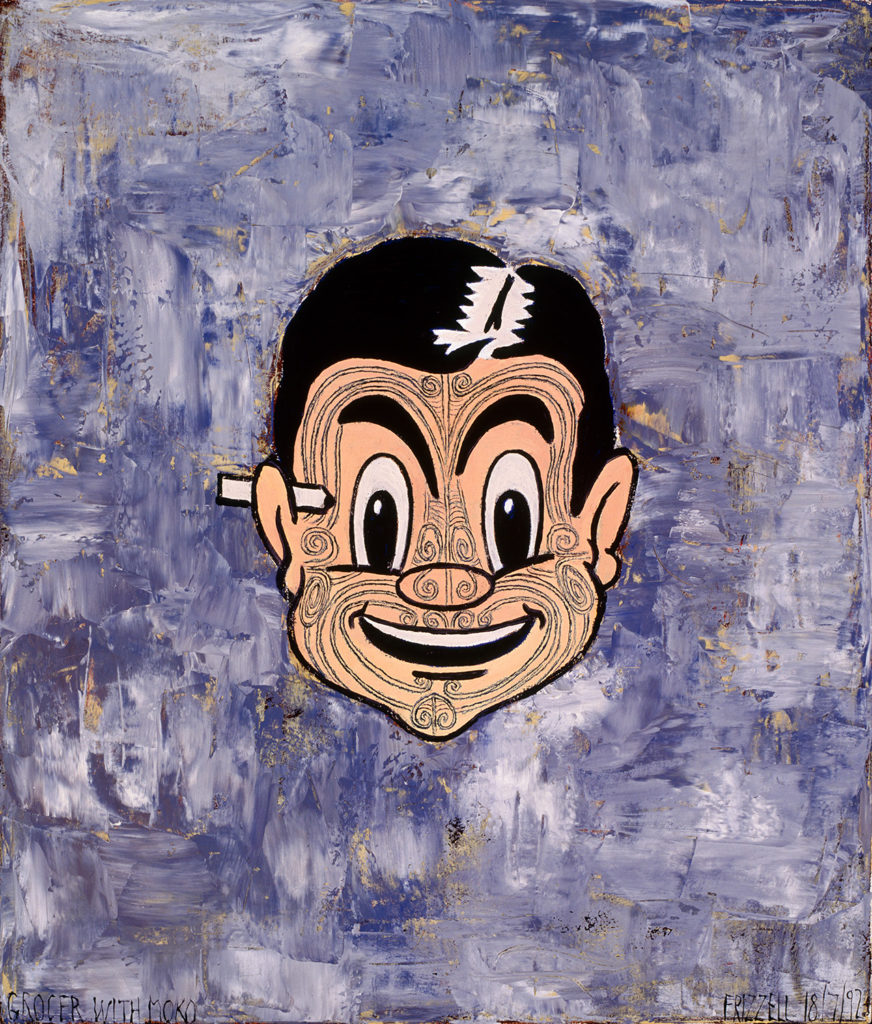CURATOR Allan Smith PARTNER Dunedin Public Art Gallery OTHER VENUES Dunedin Public Art Gallery, 7 June–17 August; Auckland Art Gallery, 30 August–16 November 1997; Govett-Brewster Gallery, New Plymouth, 13 December–8 February 1998; Waikato Museum of Art and History, Hamilton, March–May 1998 SPONSORS Saatchi & Saatchi, Creative New Zealand PUBLICATION essays Allan Smith, Robert Leonard
Painter Dick Frizzell is a key figure in New Zealand art despite—or because of—his attempts to stand apart. Covering work made since the mid 1970s, Portrait of a Serious Artiste is his greatest-hits show.
After studying at Christchurch's Canterbury School of Fine Arts in the early 1960s, Frizzell pursues a successful career as a commercial artist working across illustration, animation, and advertising. He helps animate Ches'n'Dale for the iconic Chesdale Cheese; he designs record covers and illustrates School Journals.
In the mid-to-late-1970s, he increasingly moves out of commercial work, to become a 'real' artist. However, his approach remains grounded in his commercial-art facility and ethos. His early paintings include high-art parodies and comic-book quotations (Cubist Still Life with Hulk Cover, Lemon, and Jug, 1974), pop studies of fish-tin labels (Black Geisha, 1978), and mock-heroic self portraits (Self Portrait as a Lion Tamer, 1978). In his manifesto painting, Self Portrait as a Serious Artiste, Art as Rock’n’Roll (1978), Frizzell pictures himself in a humble black singlet, but on the cover of Rolling Stone. Is it a critique of the artist hero or a narcissistic fantasy?
Critic Francis Pound includes Frizzell in his game-changing 1983 Auckland City Art Gallery show New Image, grouping him with other Auckland artists who have turned their backs on New Zealand’s moody expressive-realist landscape tradition in favour of witty, urbane, pop imagery and art in-jokes.
Throughout the 1980s, Frizzell responds to turns in the art discussion. When neo-expressionist ‘bad painting’ is in, he makes his own comic-book version of it—bad ‘bad painting’. When regionalist landscape painting is condemned, he creates an ironic pastiche of it, passing it off as ‘real painting’ to those who know no better (addressing his work to unknowing believers and knowing disbelievers alike). With Frizzell, everything is in inverted commas.
In 1992, Frizzell unveils his controversial Tiki show at Auckland’s Gow Langsford Gallery. He renders Māori tiki imagery in a variety of modern-art styles, flaunting his stylistic versatility. Deliberately provocative, the show is a response to growing artworld concern about cultural appropriation—a hot-potato issue. However, the show turns on an ambiguity: are we to read it as cultural appropriation pure and simple or as a commentary on the long history of that appropriation? Either way, Frizzell is attacked for his presumption.
After the incendiary Tiki paintings, Frizzell goes on to produce mock-modernist works, like Big Soft Stella (1994). His family dub these parodies 'Dadstracts'. They don't strike a nerve—no one is offended.
As well as the paintings, examples of Frizzell's commercial work, source materials and workbooks, and printed ephemera are presented in vitrines.
The show is supported by the Gallery’s regular sponsor, the ad agency Saatchi & Saatchi Wellington, whose mainstays Gavin Bradley and Len Cheeseman design the accompanying book—perfect brand alignment.
In his Listener review, ‘Irony Man’, Justin Paton describes Frizzell's works as 'meta-chuckling art re-runs'. He adds a cautionary note: ‘What’s much harder right now is to stand up and defend something you believe in—to say “this matters” or “that is beautiful”—without enclosing that something in embarrassed quotation marks or smothering it in nostalgia. In Frizzell’s early work, irony served as just such a defence: it was a way of protesting, gently, that the high-minded notions of the artistic vocation just ignored the unruly facts of the everyday … Yet in much recent art, and even in art as charming as Frizzell’s, “irony” has become an alibi, an escape hatch, a hedge against the possibility of emotion.’
Frizzell is an artist but also a pop-culture figure. He plays it both ways. To the serious art world, he makes lite art and makes light of art; to a wider audience, he remains a ‘real’ painter. He will continue to do commercial jobs, but they will increasingly riff on and assume his position and brand as a 'real' artist. Frizzell blurs the relationship between his art and his commercial work, between art world and real world.









































































